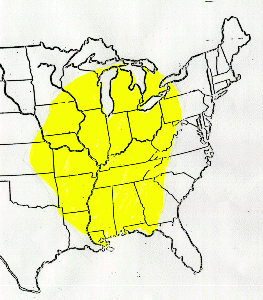
THE HOPEWELL PEOPLES
Before European settlers, even before the Odawa, Potawatomi, and Ojibwa, prehistoric people called the Hopewell built hundreds of burial mounds in the river valleys and forests of what we now call Michigan. Some Hopewell lived in the western and southern part of the Lower Peninsula. However, the most sophisticated Hopewell settlements and the largest burial mounds were in Ohio and Illinois. When they buried honored people in the mounds, the Hopewell included items that tell us about their lives.

Source: Unknown
Map showing the distribution of the Hopewell peoples (maximum extent).
The Hopewell were part of a huge trading network that stretched across the central United States. Elaborate decorations and jewelry made from Michigan copper North Carolina mica, and shells and pearls from the Gulf of Mexico were discovered in Hopewell mounds. Carved obsidian (a volcanic rock) from the Rocky Mountains and shark teeth from Virginia's Chesapeake Bay also have been found. The most ornate artifacts were in Ohio mounds. Michigan artifacts, such as pots and bowls, are simpler. Archaeologists believe the Hopewell traded furs and food, too, but they decayed long ago.
In their eating habits, the Hopewell fit between hunter-gatherers and farmers. The Hopewell may have grown some plants, but they were not a full-time farming people. They ate nuts, squash, and the seeds from several plants. Hopewell people also ate wild animals, birds, and fish.
The Hopewell people's houses were not permanent, so little evidence remains to tell about them. Scientists believe the houses had wooden pole frames covered with animal skins, grass or herb woven mats, or bark.
The Hopewell built their mounds in Michigan from 10 B.C. until about A.D. 400. Historians believe the Hopewell are the distant ancestors of the native people who still live in Michigan. Still, no one knows why they stopped building mounds or where they went after A.D. 400.
Mounds in Michigan
The Hopewell people are gone, but 17 of their burial mounds still lie in a forest
outside Grand Rapids. This group is called the Norton Mounds. Until the mid-nineteenth
century, another group called the Converse Mounds sat where downtown Grand Rapids
is today. But in the mid-1850s, farmers, construction workers, and curious people
dug into the Converse Mounds. The mounds soon disappeared and the city was built
where they had stood.
Where to take your family
The Public Museum of Grand Rapids operates the Norton Indian Mounds National
Historic Landmark, a 55-acre Hopewell Indian site. Artifacts from the mounds
are on display at the Van Andel Museum Center. For information, telephone (616)
456-3977.
Fort Hill State Memorial in Ohio contains one of the best-preserved Indian hilltop
enclosures in North America. The Hopewell Indians constructed the 1.5 mile-long
earthworks. For information, telephone (800) 283-8905.
The Newark Earthworks State Memorial in Ohio is the largest system of connected
geometric earthworks built anywhere in the world. For information, telephone
(800) 600-7174.
Hopewell Culture National Historical Park in Ohio offers a visitor center featuring
hundreds of Hopewellian artifacts. Large earthwork and mound complexes in the
park provide insight into the social, ceremonial, political, and economic life
of the Hopewell people. For information, telephone (740) 774-1126.
Some of the text and images on this page are from the September 2003 edition of "The Mitten", a publication of Michigan History magazine.
This material has been compiled for educational use only, and
may not be reproduced without permission. One copy may be printed for personal
use. Please contact Randall Schaetzl (soils@msu.edu)
for more information or permissions.